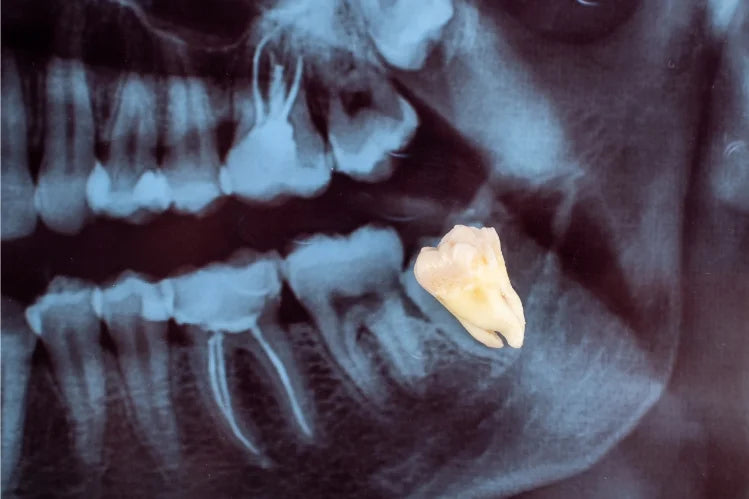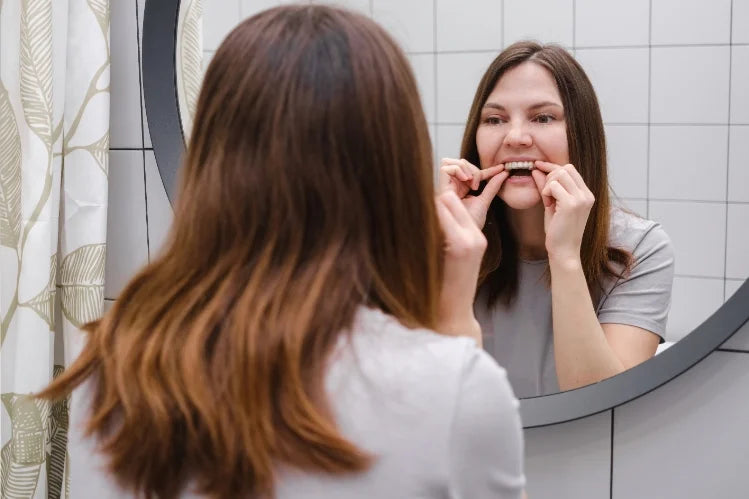
Table of Contents
- What are Posterior Teeth?
- Difference Between Posterior and Anterior Teeth
- Significance of Posterior Teeth
- Cheek and Jawline Support
- Protecting Against Jaw Strain
- .The Foundation of Good Digestion
- Speech Protection
- Alignment Protection
- Dangers to Posterior Teeth
- Cavity Risk
- Bite Imbalances
- Nighttime Grinding
- Wisdom Tooth Complications
- Mouth-Heart Relationship
- The Face-Changing Effect
- Gum Disease
- Digestive System Support
- Mental Health
- Dental Solutions for Posterior Teeth Issues
- Why Choose ALIGNERCO
- Tips to Protect Posterior Teeth
- Regular Dental Checkups
- Healthy Diet
- Avoiding Bad Habits
- Use Night Guards
- Maintain Oral Hygiene Routine
- Final Thought
- FAQs
When discussing a perfect jawline, the first thing many people think of having is perfect front teeth, doing jaw exercises like mewing, tongue positioning, or fat loss exercises. But there is more to a strong jaw and perfect teeth, a hidden secret…. Your back teeth. Here is how back teeth help…..imagine changing the door knob everyday when the real problem is the door hinge and in our jawline back teeth play the most crucial part. This blog explains the importance of back teeth and how keeping them healthy contributes to an aesthetic jawline.
What are Posterior Teeth?
Posterior teeth refer to the teeth and tissues at the back of the mouth, specifically, the molars and premolars. Though people typically don't see these back teeth when you smile, they are equally important to care for.
Types of Posterior Teeth

To understand the posterior teeth, it's important to know their types.
Premolars
As shown in the image above, premolars are located between canines and molars. Adults usually have 8 premolars, 4 on the upper jaw and 4 on the lower jaw.
Molars
Molars are located at the back of your mouth, on the upper and lower jaws. Adults normally have 12 molars, including wisdom teeth. However, some adults have fewer molars due to extractions or missing wisdom teeth.
Anatomy of Posterior Teeth

To understand the functioning of posterior teeth, let's first break down the internal working of the posterior teeth
Enamel
Enamel is the hardest substance in the body, which protects the tooth from wear and decay.
Dentin
Dentin lies beneath the enamel and transmits sensory signals to the pulp.
Roots
Roots provide strong anchorage for heavy chewing forces
Pulp
The pulp contains nerves and blood vessels, providing nutrients and sensations to the tooth.
Difference Between Posterior and Anterior Teeth

To understand the functions of the jaw, let's look at the key differences between posterior and anterior teeth.
| Feature | Posterior Teeth | Anterior Teeth |
| Types | Premolars and molars | Incisors and canines |
| Location | Back of the mouth | Front of the mouth |
| Primary Function | - Grinding and chewing food - Maintaining bite balance |
- Biting and cutting food - Aiding speech and smile aesthetics |
| Shape & Structure | - Broad, flat surfaces - Multiple cusps (bumps) for grinding |
- Thin, sharp edges (incisors) - Pointed canines for tearing |
| Role in Smile | Provide structural support for jaw alignment | Directly visible; define smile aesthetics |
Significance of Posterior Teeth
Posterior teeth are crucial in keeping up with overall oral health, functionality, and the beauty of your face and jawline. Let’s explore why they are so important.
1. Cheek and Jawline Support
Posterior teeth provide essential structural support for your cheeks and jawline. Their presence maintains your face's natural beauty and prevents the sunken, famished appearance that can occur with tooth loss.
2. Protecting Against Jaw Strain
These teeth create balanced pressure distribution during chewing. They also protect individual teeth from excessive force. This balance helps prevent jaw pain and temporomandibular joint disorders.
3. The Foundation of Good Digestion
Back teeth break down food thoroughly before swallowing, initiating proper digestion. If left unchecked, posterior teeth can lead to problems in food processing and, eventually, digestive complications.
4. Speech Protection
Clear speech requires proper airflow and tongue positioning, which posterior teeth help facilitate. They work alongside the front teeth to enable precise pronunciation.
5. Alignment Protection
Each tooth in our mouth stabilizes those next to it. When posterior teeth are affected or disappear, neighboring teeth shift into empty spaces, creating misalignment. Eventually leading to bite issues and unwanted gaps.
Dangers to Posterior Teeth
While crucial for oral function and facial structure, posterior teeth face unique challenges due to their location and role. Several common issues tend to affect these back teeth:
Cavity Risk
Back teeth develop cavities more often as their location traps food particles and makes thorough cleaning difficult. These trapped particles create an environment where bacteria thrive. Hence increasing the risk of decay significantly.
Bite Imbalances
When teeth become crowded or missing, it creates improper bite patterns that place uneven pressure on the back teeth. This abnormal force increases enamel wear, causes pain, and may trigger jaw joint disorders that damage posterior teeth.
Nighttime Grinding
Unconscious teeth grinding, particularly during sleep, gradually weakens back teeth like molars and premolars. This continual pressure makes these teeth increasingly susceptible to cracks and fractures over time.
Wisdom Tooth Complications
As the final teeth to emerge, wisdom teeth often lack sufficient space in smaller jaws. This constraint results in partial emergence or growth at problematic angles that displace neighboring teeth, causing inflammation, discomfort, and frequently necessitating extraction.
Mouth-Heart Relationship
Gum disease surrounding back teeth creates potential ways for the teeth bacteria to enter circulation and potentially harm heart tissues. So, maintaining thorough oral hygiene helps eliminate these harmful microorganisms and supports heart health.
The Face-Changing Effect
If you leave your back tooth loss untreated. It initiates jawbone deterioration in the affected area. This process creates facial sagging while allowing nearby teeth to shift position. As a result, there are misalignment issues throughout the mouth.
Gum Disease
Plaque buildup near the gumline of back teeth often triggers gingivitis and potentially periodontal disease without proper treatment. These conditions manifest as swollen, bleeding gums, persistent bad breath, and receding gum tissue. Advanced cases damage supporting bone, destabilizing teeth.
Digestive System Support
Back teeth perform the critical function of crushing food into digestible portions. When this grinding ability is decreased, the digestive system receives larger food particles. This potentially causes bloating, discomfort, and nutritional absorption issues.
Mental Health
Damaged or missing back teeth significantly affect our self-perception and social confidence. Many people experience isolation or depression because of tooth loss or misalignment. Restoring teeth will restore your physical and psychological health.
Dental Solutions for Posterior Teeth Issues
Fillings
Dentists treat mild to moderate cavities in back teeth using fillings. After removing the decayed portion, they fill the space with materials like composite resin, gold, ceramic, or amalgam. This restores function and stops further decay from developing.
Crowns
Crowns are customized caps that completely cover damaged or weakened posterior teeth. They are usually made from porcelain, metal, ceramic, or zirconia. These restorations help bring back the tooth's strength and natural shape.
Root Canal Treatment
When infection reaches the pulp inside a posterior tooth, root canal treatment becomes necessary. The dentist removes the infected pulp and seals the tooth, preventing extraction and eliminating pain.
Dental Sealants
Sealants are a thin, liquid protective coating applied to the chewing surface or groove of the back teeth. Once applied, the sealants are hardened to shield or protect the teeth from harmful, cavity-causing bacteria. These are used to protect children and adults who are more prone to cavities.
Why Choose ALIGNERCO

Now, let’s take a moment to relook at all the problems our posterior teeth face. Do your posterior teeth need restoring? Does your pain need to stay, or would you ike to go for a solution? Just imagine a solution so silent that only you would know. Yes! There is something that can take away your pain and bring you the most beautiful jawline you deserve. ALIGNERCO Clear Aligners are the most silent and easy way out. Let’s explore if their claims are true.
No Clinic Visits
With ALIGNERCO, you don't have to step out of your bed to get the posterior teeth straightening treatment. If you are suffering from crowding or teeth gaps, ALIGNERCO is here to address all your posterior teeth issues in the comfort of your home. A complete remote treatment, which means you do not have to go out for long clinic visits and appointments.
Invisible Solution
ALIGNERCO clear aligners are composed of BPA-free plastic. This plastic is invisible, which means you can have your dream smile without even getting noticed. Also, the plastic we use to make clear aligners is high quality and perfect for those who want to get their teeth straightened without compromising their appearance.
Smart Investment
With ALIGNERCO, you can save up to 40% compared to other invisible aligners. Also, we give an impressive 60% low price compared to traditional braces. Our tailored plans are designed to fit your needs while staying within your budget.In addition, individuals can benefit from our flexible financing options.
3D Smile Preview
ALIGNERCO and its integrated technology to provide quality oral care to its customers. We have introduced a 3D smile projection model to show you how your smile will look after the treatment before the treatment is even started. We know that your trust is our strength, and that’s why we start when you’re ready.Your treatment plan is closely created and supervised by licensed orthodontists to guarantee optimal results.
Tips to Protect Posterior Teeth
Posterior teeth play a crucial role in the normal functioning of your mouth and the making of your jawline, so it's important to protect them. Here are some tips to shield your posterior teeth from damage and decay:
Regular Dental Checkups
Visit your dentist every 6 months to detect dental problems early before they get expensive to rectify. He will perform professional cleaning to remove tartar. Besides, they provide advice specific to oral care for you.
Healthy Diet
Eat food that is rich in nutrients like calcium, vitamins, and minerals, and limit sugary and acidic foods that can cause decay in your posterior teeth. Drink an adequate amount of water because water helps wash away food particles and bacteria that cause bad breath.
Avoiding Bad Habits
Cracking or chewing hard materials, such as ice cubes and candies, may result in tooth cracks. Also, avoid opening bottles or tearing packages with your teeth as this can damage the enamel. Quit smoking and drinking to lower your risk of gum disease and tooth loss.
Use Night Guards
If you have an issue of bruxism (teeth grinding), wear a custom-fit night guard to protect your enamel from fracture and damage. Also, teeth grinding is often due to stress or anxiety, so practice meditation to get relief from stress.
Maintain Oral Hygiene Routine
Brush twice a day — preferably in the morning and at night. Use a soft-bristled toothbrush and fluoride toothpaste to clean the surface of your teeth. Also, floss your teeth regularly to clean hard-to-reach molars. Clean between the teeth to remove food particles and plaque build-up. Use a mouthwash to clean the bacteria.
Final Thought
The posterior teeth are important for the major functions of your mouth, like chewing and speaking. They also help to achieve a perfect jawline. Therefore, keeping them safe and healthy is essential. Knowing the proper techniques to protect posterior teeth ensures long-term health. If you face misalignments of posterior teeth, what could be a better option to correct them other than ALIGNERCO? Shop your pair of aligners and get rid of the posterior and anterior teeth problems.
FAQs
Q: What are posterior teeth?
A: Posterior teeth are the teeth and tissues that are located at the back of your mouth. They are of two types: molars and premolars.
Q: What's the difference between anterior and posterior teeth?
A: The major difference between anterior and posterior teeth is that the anterior teeth (incisors and canines) are located at the front of the mouth and help in biting and cutting food while posterior teeth (molars and premolars) are located at the back of the jaw and are responsible for chewing and grinding food.
Q: Why are posterior teeth extracted first?
A: Posterior teeth are extracted first because of decay, gum disease, or impaction (such as wisdom teeth). Also, they are difficult to clean, which makes them more prone to tooth decay and cavities.
Q: What is the function of the posterior teeth?
A: Posterior teeth help in the chewing and grinding of food. They break the food into small pieces. Also, they influence the placement of the tongue, thus helping in pronouncing words.
References
Posterior teeth. (n.d.). Science Direct. https://www.sciencedirect.com/topics/medicine-and-dentistry/posterior-teeth
Watson, S. (2023, April 20). What are the different types of teeth called? Healthline. https://www.healthline.com/health/teeth-names#diagram
Eakle, W. S., Maxwell, E. H., & Braly, B. V. (1986). Fractures of posterior teeth in adults. The Journal of the American Dental Association, 112(2), 215–218. https://doi.org/10.14219/jada.archive.1986.0344
Susanhenderson. (2024, June 1). Tooth Morphology – Permanent posterior teeth (Part A). Pressbooks. https://ecampusontario.pressbooks.pub/oralfacialonline/chapter/tooth-morphology-part-a/







